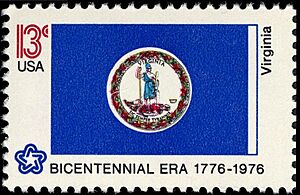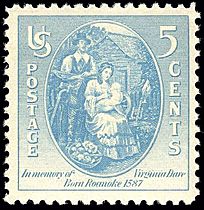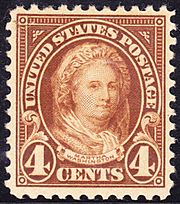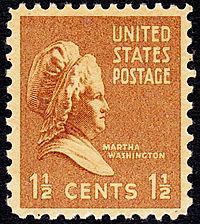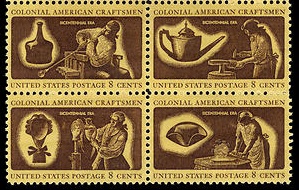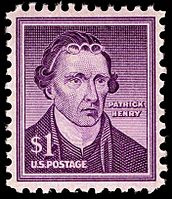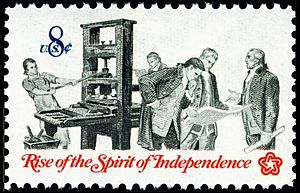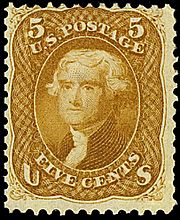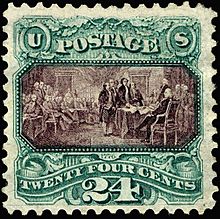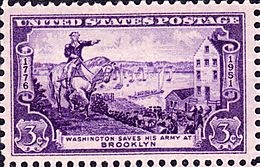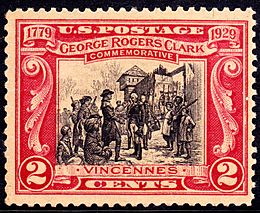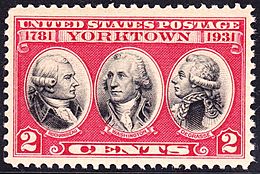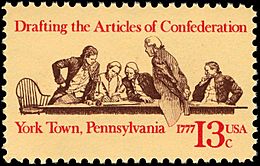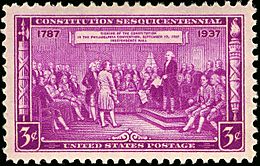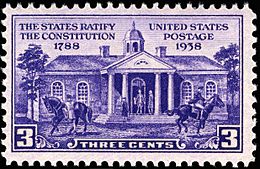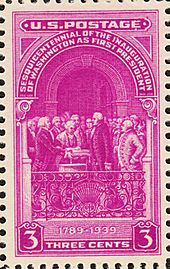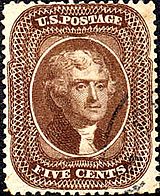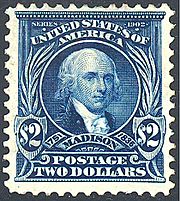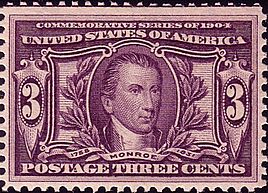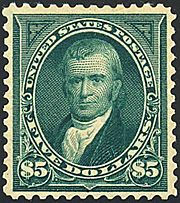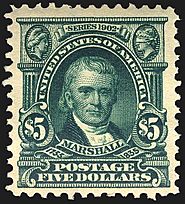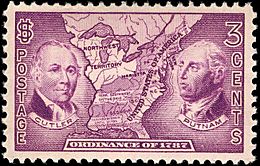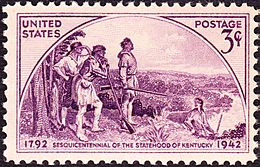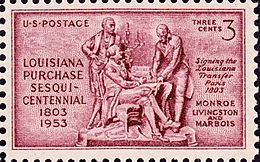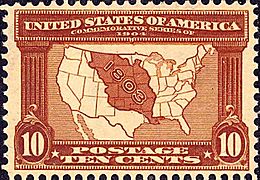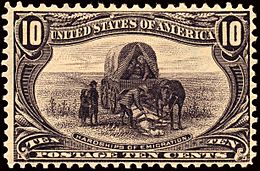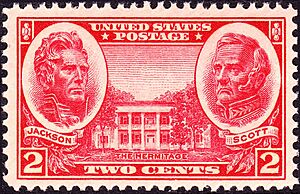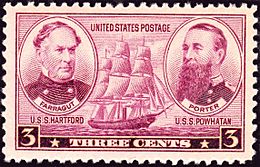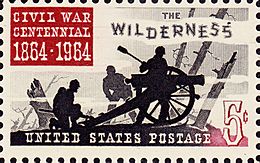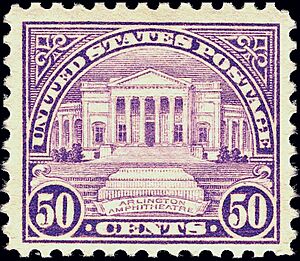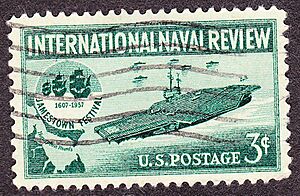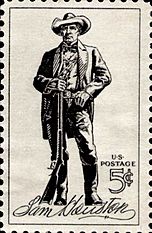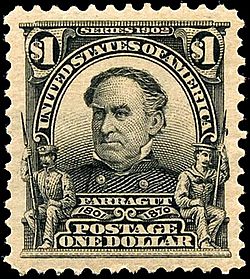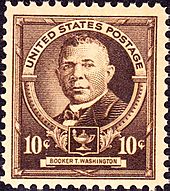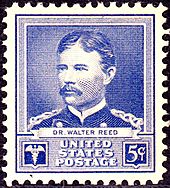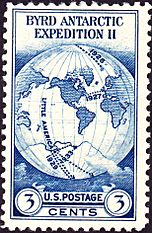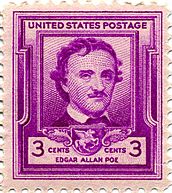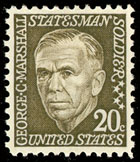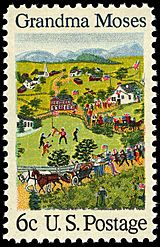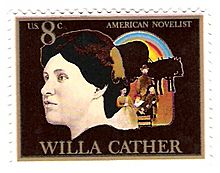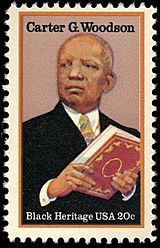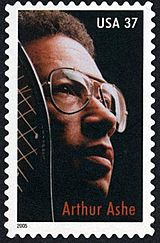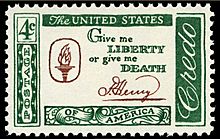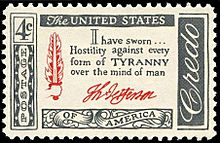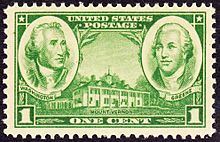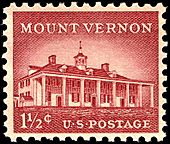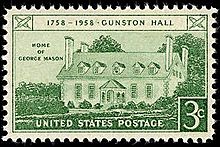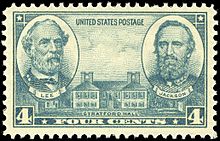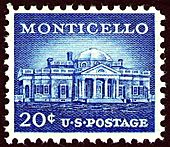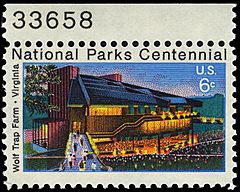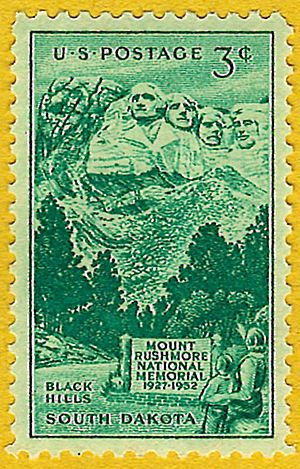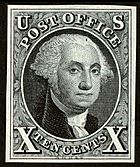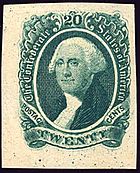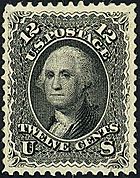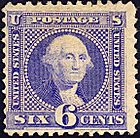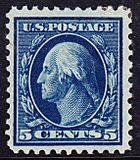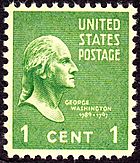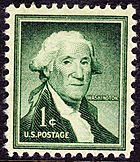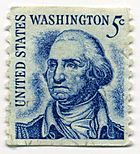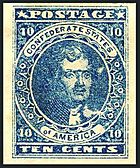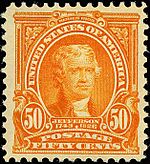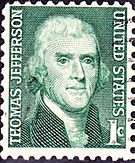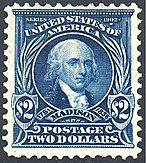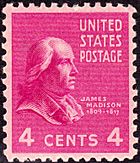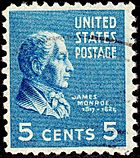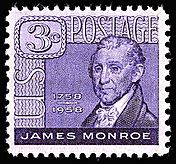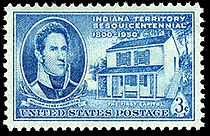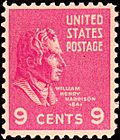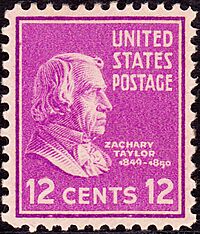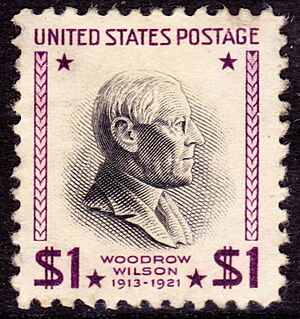History of Virginia on stamps facts for kids
The history of Virginia, from its early colonial days to modern times, has been celebrated on many postage stamps. These stamps show important people, places, and events that shaped not only Virginia but also the entire United States. You'll find stamps about early American history, famous landmarks, and presidents who were born in Virginia.
Contents
Virginia's Symbols on Stamps
Virginia's state symbols, like its flag, bird, and flower, have all appeared on stamps.
The Virginia State Flag shows the Commonwealth of Virginia's love for freedom. A 13-cent stamp featured it on February 23, 1976. This was part of the American Bicentennial Issue: Flag Series. It was the first time the USPS released a sheet with fifty different stamps. The flag's design, adopted in 1861, is deep blue. It has a white circle in the middle with a garland border. The Latin motto "Sic Semper Tyrannis" means "Thus always to tyrants." The picture shows two ancient warriors. A woman, representing Virtue (Virginia), stands over a fallen man, the tyrant, who holds a whip and chain.
- The USPS released a stamp featuring Virginia's state bird, the cardinal, and state flower, the flowering dogwood, on April 14, 1982. This was part of the State Birds & Flowers issue.
Key Moments in Virginia's History
Early Settlements and Famous People
In 1907, the U.S. Post Office released three stamps to honor the Jamestown Exposition. This event in Norfolk celebrated the 300th anniversary of the Jamestown settlement in 1607.
The 1-cent stamp shows Captain John Smith. He was a leader who helped the colony succeed. As governor, Smith famously said, "He that will not work, shall not eat." This helped end the "Starving Time." The stamp's image comes from an engraving by Simon de Passe. About 78 million of these stamps were made for postcards.
The red 2-cent stamp shows the English colonists landing. Smith's ship, The Discovery, is in the background. This stamp paid for first-class mail within the country. About 149 million were printed. The 5-cent stamp features Pocahontas. She was very important for the colony's survival. Her marriage to John Rolfe (who was famous for tobacco) brought peace between the settlers and the Powhatan tribes during her lifetime.
The picture of Pocahontas is based on a likeness by Simon Van de Passe from 1616. This image appeared in a book by John Smith in 1624. The 5-cent stamp was used for heavier mail or foreign destinations. About 8 million were issued.
- The Jamestown, Virginia settlement was honored again on its 400th anniversary. A 41-cent stamp was issued on May 11, 2007. The stamp is triangle-shaped, just like the original fort there. The sheet of 20 stamps showed a painting of early Jamestown by Richard Schlect. Archeologists who were digging at the original site reviewed the painting.
Important women from Virginia's colonial past include Virginia Dare. She was the first English child born in Roanoke, the "lost colony." A 5-cent stamp "In memory of Virginia Dare, born Roanoke 1587" was issued on her 350th birthday, August 18, 1937. She was the first child born to European parents in North America. The stamp shows a peaceful scene with a well-dressed family and a garden. In reality, the colonists faced many hardships and were likely killed by Native Americans. President Franklin Delano Roosevelt designed this stamp himself. He suggested it be baby blue and square.
Martha Custis, a widow, married George Washington. This helped him become a respected colonial gentleman. Martha Washington was America's first "First Lady." She was also the first American woman to appear on stamps. She was on an 8-cent stamp in the 1902 series. Later, she appeared on a 4-cent stamp in the 1922-31 Series. This stamp used an engraving based on a drawing by French artist Charles Francois Jalabert.
In the 1938 Presidential Series, Martha Washington was on a 1½-cent stamp. She was one of only three non-presidents and the only woman shown. Her picture came from a bust at the Memorial Continental Hall Museum. The 1½-cent rate was for "greeting card" mail from 1925 to 1948.
Daniel Boone was honored with a 6-cent stamp on September 26, 1968. He was a famous frontiersman who helped develop Virginia, Kentucky, and the western lands. The stamp shows his tools: a rifle, powder horn, and knife. A pipe tomahawk shows that the Shawnees had adopted Boone.
Colonial craftsmen were honored with 8-cent stamps on July 4, 1972, in Williamsburg, Virginia. Designed by Leonard Everett Fisher, these stamps showed glassblowing, silver making, wig making, and hat making. These are all crafts that are still re-enacted at Colonial Williamsburg.
Revolution and New Government
Virginia's Role in the Revolution
Patrick Henry was a leader in the Virginia House of Burgesses. He spoke out against Britain's unfair rules on the American colonies. Virginia tried to get the King and Parliament to listen, but it didn't work. After attending the First Continental Congress, Henry's ideas were published and spread, influencing other colonies.
Patrick Henry was on the 1-dollar stamp of the Liberty Series, issued October 7, 1955. He was governor three times. He is most famous for his speech, "Give me liberty or give me death." The stamp's image was inspired by a portrait by Alonzo Chappel.
Thomas Jefferson, who wrote the Declaration of Independence, was honored with a 5-cent stamp in 1861. This stamp was used for mail to France and other countries. The signing of the Declaration of Independence was honored with a 24-cent stamp in 1869. This stamp shows a tiny version of John Trumbull's famous painting in the U.S. Capitol.
In the Second Continental Congress, George Washington was chosen to lead the Continental Army. He personally led battles in the north.
Washington saving his army at Brooklyn was honored on a 3-cent stamp on December 10, 1951. The stamp shows Washington directing troops at Fulton Ferry house. Troops are seen crossing the East River in the background.
Major George Rogers Clark led Virginia rangers to capture Vincennes in the west. A stamp issued on February 25, 1929, honored the 150th anniversary of the British surrender there in 1779. This victory helped the U.S. gain land west to the Mississippi River.
The most important battle of the Revolutionary War was the Battle of Yorktown. This led to the Treaty of Paris (1783), where Great Britain recognized U.S. independence. Washington had help from French troops led by General Rochambeau and a French naval victory by Admiral DeGrasse.
The Revolutionary War in Virginia was honored by two 18-cent stamps on October 16, 1981, at Yorktown.
- The Battle of the Virginia Capes stamp shows the sea battle on September 5, 1781. The French fleet under Admiral Comte Grasse protected supplies for Washington against the British fleet.
- The Battle of Yorktown stamp shows the land battle. General Washington and General Rochambeau surrounded the British under General Cornwallis at Yorktown. Cornwallis surrendered on October 19, 1781, ending the American Revolution.
Creating the Constitution
The first U.S. constitution was the Articles of Confederation. Virginia gave up its claim to land north of the Ohio River to the U.S. Government. This land became the Northwest Territory. The Articles didn't have a strong executive or judicial branch. The Constitution of the United States was written to create a stronger national government. George Washington was chosen to lead the Constitutional Convention, and James Madison is known as the "Father of the Constitution."
The 200th anniversary of the Articles of Confederation was celebrated with a 13-cent stamp on September 30, 1977. Virginian Richard Henry Lee suggested a "plan of Confederation." The draft was finished in York Town, Pennsylvania, on November 15, 1777. But it wasn't fully approved until Maryland ratified it five years later. This happened after Virginia and other states gave up their western land claims.
The signing of the Constitution on September 17, 1787, was honored on its 150th anniversary in 1937. The stamp design came from a painting by Julius Brutus Stearns, showing the signers, including Virginians George Washington and James Madison.
Virginia was the tenth state to ratify the Constitution on June 25, 1788. The 150th anniversary of the Constitution's ratification was celebrated on June 21, 1938, with a 3-cent stamp. This date marked when nine of the thirteen states had approved it. The remaining four states, including Virginia, New York, North Carolina, and Rhode Island, ratified it by 1790. They did so after promises that the Constitution would add a Bill of Rights. The stamp shows the Old Court House in Williamsburg, Virginia. Two riders are about to spread the news of Virginia's ratification.
The ratification of the Constitution by Virginia was celebrated on June 25, 1988, at Williamsburg, Virginia. This was its 200th anniversary. The ceremony was held at the Capitol building, which is shown on the stamp. Virginia was the largest of the thirteen states. Without its approval, and New York's, the Constitution would have been much weaker. Virginia had leaders who supported the Constitution, like George Washington and James Madison. But it also had opponents like Patrick Henry and George Mason. Virginia only ratified it after a promise for a Bill of Rights.
Setting Up the New Government
In March 1789, Washington became the first U.S. president. He was chosen by everyone in the Electoral College. Four of the first five presidents were from Virginia. George Washington was the first, known as the "Father of his country."
Washington's presidential inauguration in 1789 was celebrated on its 150th anniversary in 1939. It happened at Federal Hall in New York City, the first capital. Washington had been chosen to lead the Continental Army, the Constitutional Convention, and the U.S. presidency twice. He was key to early U.S. history.
James Madison was a leader in the House of Representatives. He helped pass the Bill of Rights through Congress. He is known as the "Father of the Bill of Rights."
The Bill of Rights (1791) 175th anniversary was celebrated on July 1, 1966, with a 5-cent stamp. The shield-shaped design shows two hands. One hand, a gauntleted fist, suggests the "knock on the door at night" of tyranny. The other hand, held up, symbolizes the individual freedoms in the Bill of Rights.
- George Mason was honored with an 18-cent stamp on May 7, 1981. Mason refused to sign the Constitution in 1787. His criticism helped lead to the Bill of Rights. He had also written the Virginia Declaration of Rights.
- The drafting of the Bill of Rights in 1789 was honored on its 200th anniversary on September 25, 1989. This was the fifth stamp in the Constitution Series. James Madison drafted the original Bill of Rights from many state suggestions. Ten of these became the Bill of Rights.
The New Nation Grows
Virginia's Presidential Dynasty
For six presidential terms in a row, "The Virginia Dynasty" led the U.S. These were three presidents, each serving two terms: Thomas Jefferson, who wrote the Declaration of Independence; James Madison, the father of the Constitution; and James Monroe, known for the Monroe Doctrine.
Thomas Jefferson was honored with a 5-cent stamp in the 1851–1861 Issue. It was the first U.S. stamp not showing Benjamin Franklin or George Washington. The image came from a portrait by Gilbert Stuart. It was mainly used for foreign mail.
James Madison, the fourth U.S. president, is on the 2-dollar Second Bureau Issue stamp from 1902–1908. He was a leader in Virginia and helped create the Virginia Constitution of 1776. He also helped frame the Bill of Rights. As president, he led the country during the War of 1812.
James Monroe, the fifth president, was first honored on a 3-cent stamp on April 30, 1904. This was part of the Louisiana Purchase Exposition Issue. Monroe helped negotiate the Louisiana Purchase from Napoleon. He later became president and started the Monroe Doctrine.
John Marshall was a Revolutionary War veteran. He was also a delegate to Virginia's Ratification Convention. He became the fourth chief justice of the Supreme Court, appointed by President John Adams. He helped make the federal judiciary a strong, equal branch of government. He served from 1801 to 1835. His time included important cases like Marbury v. Madison (for judicial review) and McCulloch v. Maryland (for federal power).
Expanding the Nation
Virginia played a big part in the growth of the United States. It gave up land and even helped create a new state. Many people from Virginia also moved west.
Early Expansion
After the Peace of Paris, the U.S. grew. The Ordinance of 1787 helped create new states. Virginia gave up its claims to lands north of the Ohio River. The Northwest Territory was honored on its 150th anniversary with a stamp on July 13, 1937. This ordinance banned slavery in the territory. It also set rules for buying land from Native Americans and selling it to settlers.
With the new Constitution, Virginia asked Congress to make Kentucky a separate state in 1792. Kentucky's admission was celebrated on its 150th anniversary with a 3-cent stamp on June 1, 1942. The stamp shows Virginia explorer Daniel Boone and his friends looking over the Kentucky River.
Louisiana Purchase and Exploration
James Monroe helped negotiate the Louisiana Purchase in Paris. This deal doubled the size of the U.S. under President Thomas Jefferson. Virginians Meriwether Lewis and William Clark explored this new territory and traveled all the way to the Pacific Ocean on the Lewis and Clark Expedition.
- The Louisiana Purchase Bicentennial was honored with a 37-cent stamp on April 30, 2003. This purchase made the U.S. one of the largest countries and opened up vast new lands.
- The Lewis and Clark Expedition was celebrated on May 14, 2004, its 200th anniversary. Two 37-cent stamps showed portraits of Meriwether Lewis and William Clark.
Westward Movement
Virginia was called the "mother of states" because so many people moved from there to other parts of the country in the 1800s. While many moved to western and northern states, Texas leaders Sam Houston and Stephen Austin were both from Virginia.
Mexican-American War
Winfield Scott was a U.S. hero of the Mexican-American War. He captured Mexico City. He suggested that Virginia-born Zachary Taylor lead the northern U.S. army. The land gained from Mexico was called the Mexican Cession. This helped the U.S. achieve its idea of Manifest Destiny, expanding from the Atlantic to the Pacific.
The 1937 stamp shows Scott alongside Andrew Jackson, the "Hero of New Orleans" from the War of 1812.
The Civil War and Its Impact
Virginia Generals and Battles
At the start of the American Civil War, Winfield Scott was the senior commander of the U.S. army. Union admirals included David Farragut. Union General George Henry Thomas became famous as the "Rock of Chickamauga." Opposing them were fellow Virginians, Generals Robert E. Lee and Thomas Jonathan Jackson. General J.E.B. Stuart was a famous cavalry commander.
Lee is shown on a stamp issued September 21, 1955, in Norfolk, Virginia. His victories leading Confederate forces against larger armies earned him lasting fame. After the war, he encouraged peace from his post as president of Washington College (now Washington and Lee University).
- Robert E. Lee was honored with a 32-cent stamp in the American Civil War Issue of June 29, 1995. His horse Traveller is in the background.
Virginia was a major battlefield with many campaigns between Washington D.C. and the Confederate capital at Richmond. These included the Battle of First Bull Run in 1861, the 1862 naval ironclad Battle of Hampton Roads, Jackson's Valley Campaign, McClellan's Peninsula Campaign, Battle of Second Bull Run, Battle of Fredericksburg, the 1863 Battle of Chancellorsville, the 1864 Overland Campaign in the Virginia Wilderness and the Siege of Petersburg. In 1865, Lee's army surrendered at Appomattox.
- The Battle of Hampton Roads was honored with a 32-cent stamp on June 29, 1995.
- The Battle of Chancellorsville was honored with a 32-cent stamp on June 29, 1995.
West Virginia became a state after the Wheeling Conventions. Fifty northwestern counties of Virginia, whose people felt they weren't fairly represented, became a new state on June 20, 1863. West Virginia statehood was honored on its 100th anniversary with a 5-cent stamp on June 20, 1963.
World Wars and Modern Virginia
Virginia in the World Wars
In World War I, Virginia had training facilities and expanded shipbuilding. The Hampton Roads served as a major port for the U.S. Army. Virginia-born President Wilson led the country during World War I. The World War I Tomb of the Unknown Soldier is at Arlington National Cemetery in Arlington, Virginia. The Arlington Cemetery Amphitheater was honored in the 1920s. A 50-cent stamp was issued on November 11, 1922, the first anniversary of the Unknown Soldier's burial.
The Marine Corps War Memorial, also known as the Iwo Jima Memorial, is in Arlington, Virginia. A replica is at the Quantico Base main gate. The sculpture shows Marines raising the U.S. flag over Mount Suribachi during the Battle of Iwo Jima. This scene was reproduced on a 3-cent stamp on July 11, 1945.
- Virginia National Guard Army units were part of the 29th Infantry Division (United States). This division landed on D-Day at Normandy beaches in World War II. The USPS honored the 50th anniversary of WWII with a sheet of ten 29-cent stamps on June 6, 1994. The National D-Day Memorial is in Bedford, Virginia.
Recent Virginia Developments
Shipbuilding in the Hampton Roads is still a big industry. The Norfolk Navy Base is one of the largest in the world.
The International Naval Review and Jamestown Festival were honored with a 3-cent stamp on June 10, 1957, in Norfolk, Virginia. The stamp shows a super carrier and escort ships approaching a map of the Hampton Roads. On the left is the three-sailing-ship logo of the Jamestown Festival.
Other Famous Virginians
Many Virginians became famous both in Virginia and elsewhere. These include Texas statesman Sam Houston, Naval officer David G. Farragut, educators Booker T. Washington and Carter G. Woodson, poet Edgar Allan Poe, artist Grandma Moses, army doctor Walter Reed, athlete Arthur Ashe, explorers Daniel Boone, Lewis and Clark, and Richard E. Byrd, and military leaders George C. Marshall and "Chesty" Puller.
Samuel (Sam) Houston was honored on a 5-cent stamp in 1964. He is most famous for defeating Mexican General Santa Ana in 1836 to win Texas independence. He then became its president. He was also the only person to serve as governor of two states: Tennessee and Texas.
Admiral David G. Farragut was honored on the 1-dollar stamp of the Second Bureau issue. When Virginia left the Union in 1861, Farragut moved his family north. He captured New Orleans in 1862 and won Mobile Bay in 1864.
Booker T. Washington was the first African-American to be shown on a U.S. stamp. This was the 10-cent Famous American Educators issue of April 7, 1940. Born a slave, he became president of Tuskegee Negro Normal Institute (Tuskegee University). He taught practical, job-related skills.
Dr. Walter Reed, a U.S. Army physician, was honored on the 5-cent Famous American Scientists stamp issued April 17, 1940. He studied contagious diseases. He famously linked flies to typhoid fever and mosquitoes to yellow fever.
- Along with Daniel Boone, Meriwether Lewis and William Clark were also famous Virginian explorers. Their individual stamp portraits appear above in the Louisiana Purchase section.
Richard E. Byrd's Antarctic Expedition II was honored on a 3-cent stamp on September 22, 1933. These stamps were carried by the expedition and postmarked at their base camp, Little America.
The 100th anniversary of Edgar Allan Poe's death was honored with a 3-cent stamp on October 7, 1949, in Richmond, Virginia. His poems and short stories are famous worldwide.
- Edgar Allan Poe's 200th birthday was celebrated with a 42-cent stamp on January 16, 2009.
George C. Marshall was honored with a 20-cent stamp on October 24, 1967. He was a graduate of Virginia Military Institute. During WWII, he was Army Chief of Staff. After the war, he was Secretary of State and created the "Marshall Plan," for which he won the Nobel Peace Prize.
Grandma Moses was honored with a 6-cent stamp in 1969. She started painting in her seventies after retiring from farm work in Virginia. She was a self-taught artist who produced over 1,500 paintings. Her work shows rural scenes and traditional activities.
Willa Cather, born near Winchester, Virginia, was a famous 20th-century novelist. She was honored with a stamp in 1973. Her stories often took place on the Great Plains. She won a Pulitzer Prize for her 1922 novel 'One of Ours'.
- Carter G. Woodson was honored with a 20-cent stamp in the Black Heritage Series on February 1, 1984. He is pictured holding a book on black history. He is known for formalizing the study of academic black history in America. Black History Month grew out of his initial celebration of Black History Week in 1926.
- Arthur Ashe was honored on a USPS 37-cent stamp on August 27, 2005. He was the first African-American to win the Grand Slam in tennis. Ashe was known for his intelligence, strong character, and work for social causes. Born in Richmond during the Jim Crow era, he spoke out against racism.
- Chesty Puller (Lewis B. Puller) of West Point, Virginia, was honored on November 10, 2005. He was one of four legendary Marines known for bravery in the 20th century.
Virginia's Landmarks and Ideas
The Thomas Jefferson Memorial in Washington, D.C., was honored with a 10-cent stamp on December 14, 1973. The stamp features the famous phrase from the Declaration of Independence, "We hold these truths..." which Jefferson wrote. Thomas Jefferson also wrote the Virginia Statute of Religious Freedom, which separated church and state in Virginia.
Three of the American Credo Series stamps feature quotes by Virginians. "Credo" means "I believe" in Latin. Six American heroes were chosen, and the Virginians were George Washington, Thomas Jefferson, and Patrick Henry.
George Washington's quote is on the first 4-cent stamp in the American Credo Series, issued on January 20, 1960. The words, "Observe good faith and justice towards all nations," are from Washington's Farewell Address in 1796.
Thomas Jefferson's quote is on the third 4-cent stamp, issued on May 18, 1960. The words, "I have sworn hostility against every form of tyranny over the mind of man," are from his writings.
Patrick Henry's quote is on the sixth 4-cent stamp, issued on January 11, 1961. The words, "Give me liberty or give me death," are from his famous speech in 1775.
- "Give me liberty or give me death" -- Patrick Henry.
- "I have sworn ... hostility against every form of tyranny over the mind of man." -- Thomas Jefferson.
- "Observe good faith and justice towards all nations." -- George Washington.
Virginia landmarks in Northern Virginia honored on stamps include Mount Vernon, George Washington's home, and his neighbor George Mason's home at Gunston Hall.
Mount Vernon was the background for a 1-cent Army commemorative stamp issued December 15, 1936. It shows portraits of Washington and Nathanael Greene. Mount Vernon was also the first of the "shrines" in the Liberty Series, a 1-1/2-cent stamp issued on February 22, 1956.
Gunston Hall, George Mason's home, was honored on June 12, 1958, by a 3-cent stamp. It shows the brick home built in 1758. Mason wrote the "Fairfax Resolves" and the Virginia Declaration of Rights.
Stratford Hall in the Northern Neck, Monticello outside Charlottesville, Carlyle House and Gadsby's Tavern in Alexandria have also been featured.
Stratford Hall, Robert E. Lee's family home, was the background for a 4-cent Army commemorative stamp issued March 23, 1937. It shows portraits of Lee and Stonewall Jackson.
Monticello was one of the three "shrines" in the Liberty Series (1954–1968). It appeared on a 20-cent stamp issued on April 13, 1956, Jefferson's birthday.
The Alexandria bicentennial was celebrated on May 11, 1949, with a 6-cent airmail stamp. It featured both Old Town colonial "Carlyle House" and "Gadsby's Tavern."
The Old Court House in Williamsburg is shown above, honoring the Constitution's ratification in Virginia.
Washington and Lee University, founded in 1749, was honored on its 200th anniversary with a 3-cent stamp on April 12, 1949. The stamp shows the university with portraits of Washington and Lee.
Wolf Trap Farm was honored with a 6-cent stamp on June 26, 1972. Wolf Trap Farm Park is now a National Park for the Performing Arts in Vienna, Virginia.
- The Civilian Conservation Corps (CCC) was honored with a 20-cent USPS stamp on April 5, 1983. It shows construction along the Appalachian Trail. President Franklin D. Roosevelt created the CCC in 1933. It employed young men to develop and conserve natural resources during the Great Depression.
- The Virginia colonial capitol building at Williamsburg is pictured in a 1988 USPS stamp.
- Montpelier, James Madison's home, is featured on a stamp issued October 18, 2001.
- The Rotunda (University of Virginia) was honored on a 15-cent American Architecture series stamp on June 4, 1979.
- Washington Dulles International Airport in Dulles, Virginia, was honored on a 20-cent American Architecture series stamp on September 30, 1982.
- Old Cape Henry Lighthouse was honored in the 37-cent Southeastern Lighthouses issue on June 13, 2003. It was the first lighthouse built by the U.S. government in 1792.
Virginia's Presidents on Stamps
Eight U.S. presidents were born in Virginia. Some, like William Henry Harrison and Zachary Taylor, made their careers in other states. Woodrow Wilson also made his career elsewhere.
Sam Houston, born in Virginia, became president of the Republic of Texas. Joseph Jenkins Roberts was the first president of the Republic of Liberia.
Virginia presidents Washington and Jefferson are on Mount Rushmore in South Dakota. This tribute was honored on a 3-cent stamp on August 11, 1952.
- Five Virginian presidents—Washington, Jefferson, Madison, Monroe, and William Henry Harrison—are on 22-cent stamps. These were part of the "Ameripex '86 Issue" released on May 22, 1986.
George Washington on Stamps
George Washington was on the 1847 10-cent issue, one of the first two U.S. stamps ever. He was also a main image on Confederate 20-cent stamps in 1863.
George Washington appeared on the 12-cent stamp in the 1861 issue. Two 12-cent stamps paid for postage to England. He was also on four other stamps in that issue.
George Washington was featured on the 6-cent 1869 Pictorial issue. Of the first twenty U.S. stamps, eleven showed Washington. He was shown as an army commander, convention leader, or first president. The 6-cent stamp paid for double-weight domestic mail. On all stamps from 1870 to 1932, Washington was the only person on the regular letter rate stamp.
George Washington was on twelve of the thirteen stamps in the original Third Bureau series (1908–09). He was also on the 1-cent 1938 Presidential Series stamp. Washington, the "Father of his country," has been on more U.S. stamps than anyone else.
George Washington was honored on the 1-cent Liberty Issue (1954–1968) on August 26, 1954. The image came from a Gilbert Stuart portrait.
George Washington was featured on the 5-cent issue of February 22, 1966. He was praised by Henry Lee as "first in war, first in peace, first in the hearts of his countrymen."
Thomas Jefferson on Stamps
Thomas Jefferson was honored in both the Union and the Confederacy. He appeared on a Confederate 10-cent stamp starting November 8, 1861.
Thomas Jefferson is on the 50-cent stamp in the Second Bureau Issue (1902–1908). He is honored more often on U.S. stamps than anyone except Washington, Franklin, and Lincoln. As president, Jefferson famously doubled the size of the United States with the Louisiana Purchase.
Thomas Jefferson appears on the 3-cent 1938 Presidential Series stamp. He was the third president and a key founder of the United States, writing the Declaration of Independence. The 3-cent stamp was widely used for first-class domestic mail.
Thomas Jefferson is on the 1-cent stamp in the Prominent Americans Issue (1965–1978), released on January 12, 1968. His successes as president included reducing national debt and fighting pirates.
- Thomas Jefferson was featured on the 29-cent Great Americans series on April 13, 1993.
James Madison on Stamps
James Madison, the fourth U.S. president, was honored on the 2-dollar First Bureau Issue stamp of 1894. He was a leader in Virginia and helped frame the Bill of Rights. As Secretary of State under Jefferson, his presidency included the War of 1812.
James Madison appears on the 4-cent 1938 Presidential Series stamp. Madison, the "Father of the Constitution," suggested the system of checks and balances in government.
- James Madison was honored on a stamp issued October 18, 2001, for his 250th birthday. His home at Montpelier is in the background.
James Monroe on Stamps
James Monroe is honored on the 10-cent stamp of the 1923 series. He served as president from 1817 to 1825.
James Monroe appears on the 5-cent 1938 Presidential Series stamp. He was a leader in the Revolutionary War and is known for the "Monroe Doctrine."
James Monroe (1758–1831) appears on the 5-cent Liberty Series stamp issued December 2, 1954. The portrait is by Rembrandt Peale.
James Monroe was celebrated on his 200th birthday, April 28, 1958, with a 3-cent stamp.
William Henry Harrison on Stamps
William Henry Harrison is featured on the 150th anniversary of the Indiana Territory (1800) stamp issued July 4, 1950. Harrison was the first governor of Indiana Territory and later the 9th U.S. president.
William Henry Harrison appears on the 9-cent 1938 Presidential Series stamp. He was a hero of the Indian Wars and the War of 1812. He was the first president to die in office.
John Tyler and Zachary Taylor on Stamps
John Tyler appears on the 10-cent 1938 Presidential Series stamp. He was the tenth president and the first vice president to become president when the sitting president died.
Zachary Taylor was honored in the 5-cent "Large Bank Note Issues" of 1879–1881.
Zachary Taylor appears on the 12-cent 1938 Presidential Series stamp. He was the twelfth president and a soldier for over forty years. He was a national hero during the Mexican War.
Woodrow Wilson on Stamps
Woodrow Wilson was honored on the 17-cent Series of 1922, issued on December 28, 1926. This stamp was a memorial to him after his recent death.
Woodrow Wilson appears on the 1-dollar 1938 Presidential Series stamp. He was the twenty-eighth president and led the United States through World War I. He won the Nobel Peace Prize in 1920.
Images for kids


